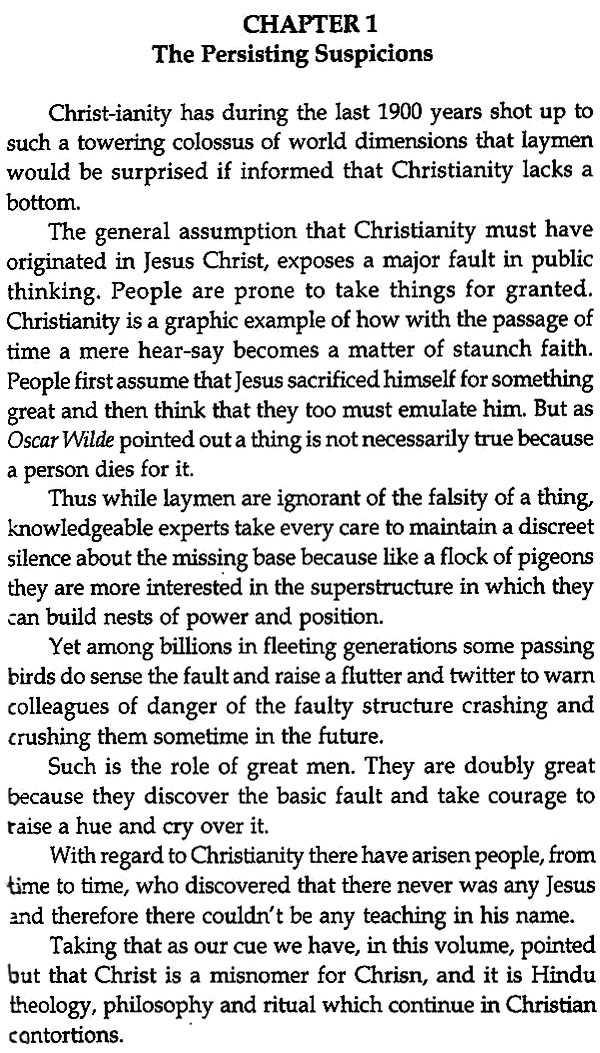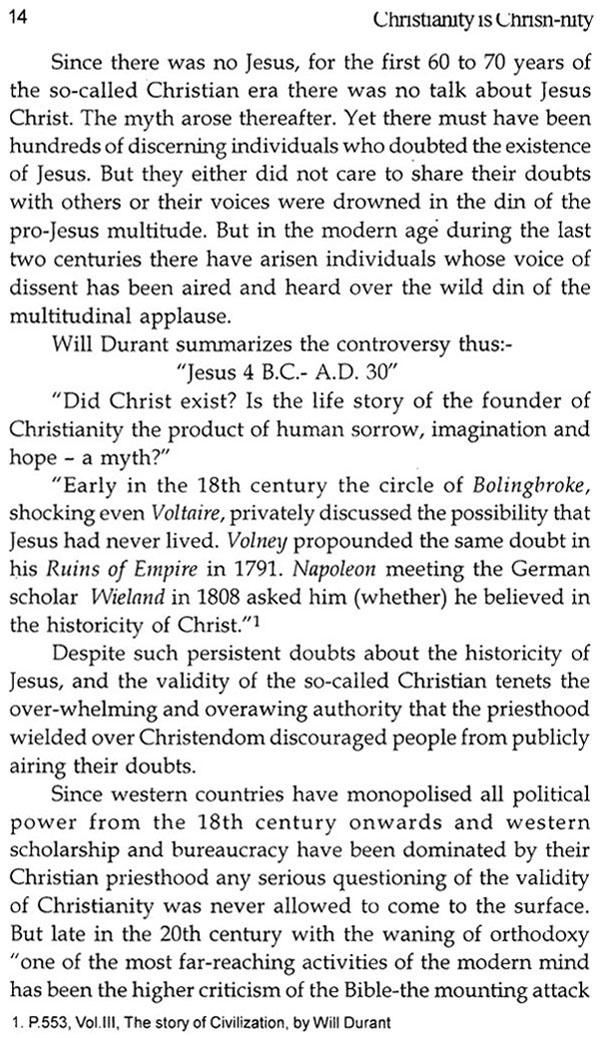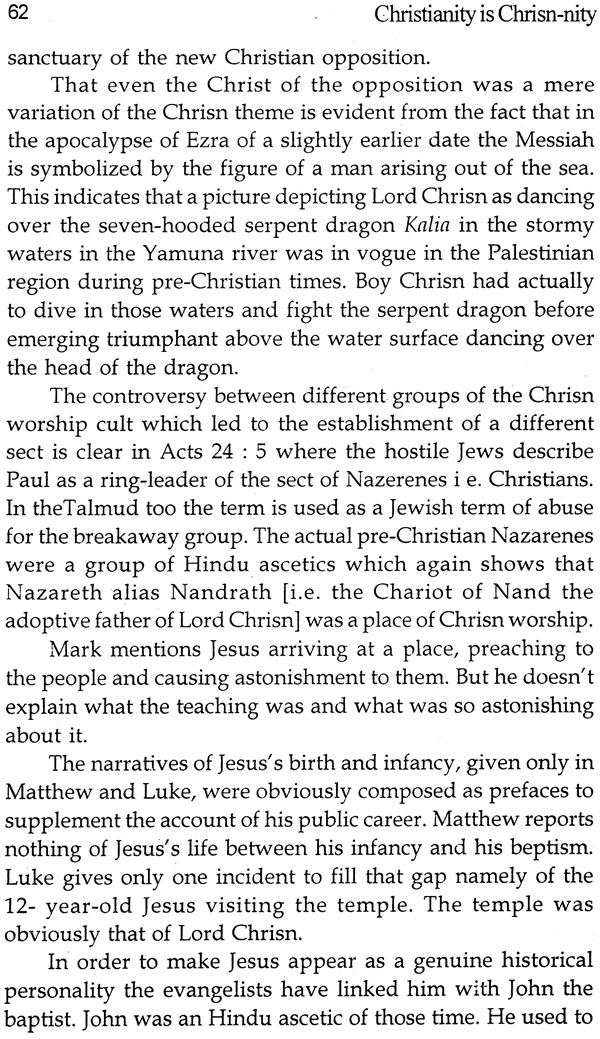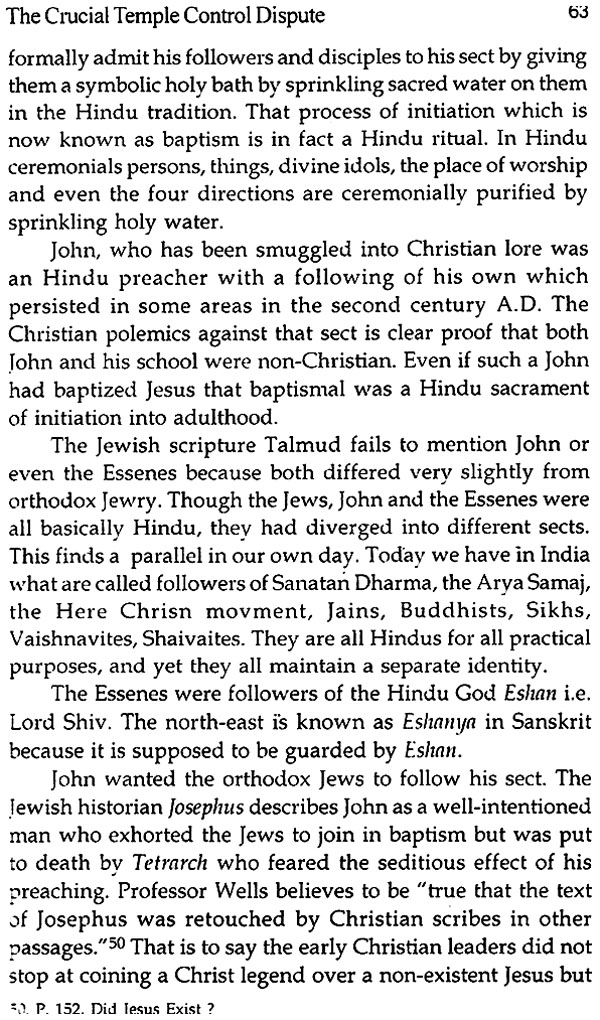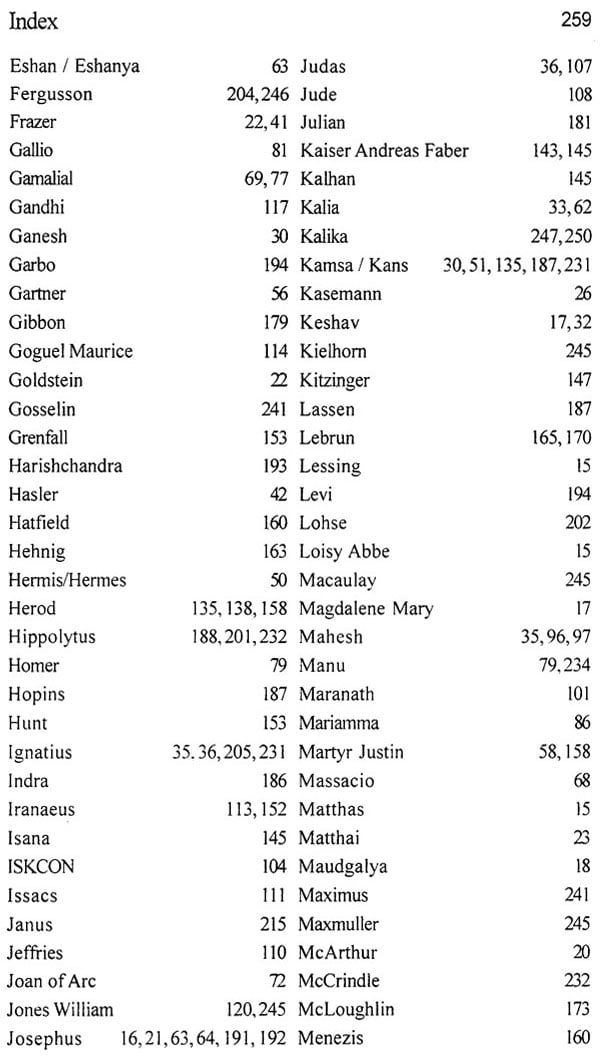
Christianity is Chrisn-Nity
Book Specification
| Item Code: | NAS305 |
| Author: | P.N. Oak |
| Publisher: | Hindi Sahitya Sadan |
| Language: | English |
| Edition: | 2012 |
| ISBN: | 8188388777 |
| Pages: | 261 |
| Cover: | PAPERBACK |
| Other Details | 8.50 X 5.50 inch |
| Weight | 340 gm |
Book Description
The author, P.N. Oak having made some far-reaching discoveries in history, is the founder president of the Institute for Rewriting World History. His latest finding is that in pre-Christian times Vedic culture and Sanskrit language held full sway throughout the world.
P.N. Oak was born in a Maharashtrian Brahmin family in which his father talked to him only in Sanskrit, mother only in English, relations in Marathi and town-folk in Hindi. That gave him fluency in these four languages from childhood.
After obtaining his B.A. degree from Agra University and completing M.A., LL.B, courses of the Bombay University, Oak worked for a year as tutor in English at the Fergusson College, Pune and later having joined the army was posted to Singapore at the age of 24.
There, after the British surrender, Oak was one of the organizers of the Indian National Army, a director and commentator at the Free India Radio, Saigon, and later a co-worker of Netaji Subhash Chandra Bose.
After the end of World War II, Oak hitch-hiked from Singapore to Calcutta across the border jungles of several countries.
From 1947 to 1974 his profession was mainly journalism having worked on the editorial staffs of the Hindustan Times and the Statesman, as a class I officer in Ministry of Information and Broadcasting, Government of India, and as editor in the American Embassy’s information service, all in New Delhi.
Around 1959, Oak developed a curious new insight into history which led him to some stunning discoveries as a result of his absorbing hobby of visiting historic sites. He then founded (June 14, 1964)the institute for Rewriting Indian History and wrote several books (listed) elsewhere in this volume).
Oak’s historical acumen led him to discover further that even world history has gone wrong. His discoveries have therefore, outgrown the name and scope of the Institute for Rewriting Indian History. Having discovered that from time immemorial up to the Mahabharata War, Vedic culture and Sanskrit pervaded the whole world.
Oak was keen to find a world Vedic Heritage University to educate the world in the primordial Vedic unity of all humanity.
The title of this book ‘Christianity is Chrisn nity’ is likely to evoke mixed reactions. Many are likely to feel intrigued and confused and wonder what Chrisn-nity could be and how it could have led to Christianity. Several others are likely to feel dismayed. Some others might be so shocked to feel disinclined even to touch this book, much less to read it.
This is a common human failing. In picking up ever new book the implication is that it will have something new to say. And yet when it actually says something new the reaction is "Bah ! This is ridiculous, never heard of such a thing." That is to say, though superficially one may pretend to be perpetually receptive, inwardly and unwittingly one is inclined to agree only with that which repeats or corroborates one’s innate beliefs.
This leads us to the rule that just as to benefit fully from a bath one has to step into the water nude similarly to benefit from a new thesis one’s mind must strip itself of all reservations, inhibitions, fears, prejudices, preconceived notions, assumptions and presumptions.
One such common assumption these days is that Christianity is a religion founded by Jesus Christ. This book seeks to prove that there was no Jesus and therefore there couldn’t be any Christianity. If such a possibility is not likely to give you a shiver only then can you hope to enjoy swimming in the transparent thesis of this book warmed with evidence and perfumed with appealing argument.
It may come as a revelation to many that ‘Christianity’ is the Sanscrit term Christ-nity (or more properly Christ-neety) meaning the way of life preached, advocated or exemplified by Christ.
This volume expounds our finding that Christ being no historical person, the term Christianity is in fact a popular variation of the ancient Hindu, Sanscrit term Chrisn-neety i.e. the way of life preached, advocated or exemplified by the Hindu incarnation Lord Chrisn spelled variously as Crsn, Krsh, Krishn, Chrisn, Crisna or Krisna also.
Chrisn being pronounced as Christ is not a European peculiarity. It started in India itself. In the Bengal region of India, for instance, individuals names as Chrisn are accosted as Christ.
We claim no credit for the discovery that Jesus Christ is not a historical person. For at least two hundred years in the past people have all along suspected that the Christ legend is a fiction. Eminent people like Napoleon have, from time to time, openly aired their doubts. Recently a number of exhaustive treatises in several European languages, written by European scholars exposing the falsity of the Christ legend have been published.
But we do claim credit for four distinct discoveries, viz:(I) The Chrisn origin of the Christ legend, (2) that the Bible far from being a religious scripture, is an hodge podge, coded, allegorical account of a breakaway group of the Chrisn cult, (3) that the fictitious story of Jesus has been patterned after the life of St. Paul, and (4) that the European tradition of reckoning the beginning of a new day from the midnight hour stems from the preponderance of Chrisn worship among them. In Hindu tradition the birth of Chrisn marks the end of the dark days of demoniac tyranny and torture. Chrisn’s birth heralded the dawn of a new era of peace, prosperity and happiness. The European practice of counting the hours from midnight onwards reflects exactly that Hindu sentiment, proving in its own turn that ancient Europe was a Hindu region.
European scholars’ discovery that Jesus Christ is an imaginary character is only a half way house which leaves one all the more puzzled because it fails to clarify why and how did the Jesus Christ legend originate.
Moreover one wonders that if there was no Jesus Christ what all this pother about Christianity.
The present volume provides that missing last link pointing out that Christianity is nothing but a European and West Asian distortion of the ancient Hindu Chrisn-cult.
As a concomitant of that we also prove in this volume that since Jesus was never a living person the Bible far from being a scripture, is a partly coded and partly allegorical story of a rift among the controllers of the Chrisn temples in Jerusalem and Corinth, and its aftermath.
The dissident faction whipped up an agitation obviously with the limited aim of wresting control of the Chrisn temple managements. Saul alias Paul was its leading figure. It is Paul who is personified as Jesus in the Bible. The twelve apostles symbolize the 12 tribes of the Jews whose backing Paul desired. It is therefore Paul who is the hero of the Bible in the guise of Jesus.
Much beyond their wildest expectations, however, the agitation led by Paul, Peter, Stephanas etc. developed into a torrent carrying the agitators themselves helplessly past the Chrisn cult and casting them adrift on an unknown coast which they bewilderingly still believed to be Chrisn-nity but spelled as Christianity.
The Bible is an allegorical account of that struggle in which the agitators, gathering strength, became a threat to the Jew citizenry and the Roman officialdom. The Jews were afraid that this special culture would be swamped if they were all baptized Christians. The Roman bureaucrats, on the other hand, feared that the Chrisn temple management dispute was threatening to assume the proportions of an open public revolt against the provincial administration itself.
Their fears were obviously well-founded as it turned out later from the way Christianity put Judaism in the shade and crushed and buried the colourful pre-Christian culture of Rome.
During that interregnum of nearly four centuries the agitators were from time to time reported to the Roman officials by the Jews, and were punished for their crimes.
The Jews reported the agitators to the Roman authorities because they were disturbing the peace by fanatically and violently spreading the myth of Jesus. On this pat the Roman magistrates obliged to take action to prevent or quell those new riots.
The agitation, obviously, progressively sparked off scuffles, brawls, murders, mass protects, boycotts and no-tax campaigns as may be inferred from references to over-turning money-changers’ tables inside the temple premises, and the question posed whether tax due should be remitted to Caesar. It was in an attempt to crush that revolt that the rebels were stoned to death or crucified.
It is that struggle which the Bible records and narrates. That is why the Bible includes the correspondence of Paul and others involved in that agitation directly and indirectly.
The imaginary Jesus personifies the protesters in general and Paul in particular. His crown of thorns, the jeering of the crowds, humiliation, travails and the ultimate crucifixion epitomize the story of the agitators. Correspondingly the imaginary Judas Iscariot personifies mainly the Jews who used to report the agitators to the Roman administration, while the resurrection symbolizes the emergence of the protesters as a powerful group.
The Bible makes sense only if it is thus studied as a coded and allegorical history of that struggle.
**Contents and Sample Pages**

